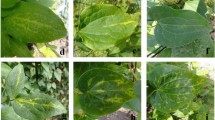Abstract
Pepino mosaic virus (PepMV), a member of the genus Potexvirus, was first described in South America on pepino (Solanum muricatum A.). Only in recent years, it was reported to infect greenhouse-grown tomatoes. Genome nucleotide sequences from several European isolates showed extensive sequence identity (>99%). Recent genome nucleotide sequences from two US isolates (US1 and US2) however showed much greater sequence divergence from that of the European PepMV isolates. My interest in characterizing virus isolates from South America was due to an active commercial tomato seed production in Chile. Through genome sequence comparison and phylogenetic analyses, we may be able to understand the source of virus infection and control this devastating disease from further spreading into new tomato growing regions of the world. Complete genome nucleotide sequences from two PepMV variants (designated as Ch1 and Ch2) were determined from a virus isolate obtained from a commercial tomato seed lot produced in Chile. Using RT-PCR-based genome walking strategy, complete genome sequences from these two variants were determined. Excluding poly (A) tails, the genomes of PepMV Ch1 and Ch2 were 6414 and 6412 nucleotides (nt), respectively. Pairwise comparisons of PepMV Ch1 and Ch2 genomes with other PepMV isolates showed that the highest nucleotide sequence identity was with two US isolates, 98.7% between PepMV Ch1 and US1, and 90.7% between Ch2 and US2. Similar to PepMV US1 and US2, the two Chilean variants were the most divergent from one another (78% nt identity). These two Chilean PepMV variants also shared only 78–86% nucleotide sequence identity to that of five European isolates. The high level of nucleotide sequence identity between Chilean and US isolates suggests a common origin. Phylogenetic analyses with various gene products generated three distinct sequence clusters (or strains): US1 and Ch1 in the first group, US2 and Ch2 in the second, and the European tomato isolates in the third. Based on the host specificity, it was previously suggested that the original pepino isolate should be considered a distinct strain from that of the tomato isolates.


Similar content being viewed by others
References
R.A.A. Van der Vlugt, C.C.M.M. Stijger, J.Th.J Verhoeven, D.E. Lesemann, Plant Dis. 84, 103 (2000)
J.M. Aguilar, M.D. Hernandez-Gallardo, J.L. Cenis, A. Lacasa, M.A. Aranda, Arch. Virol. 147, 2009–2015 (2002)
A.C. Cotillon, M. Girard, S. Ducouret, Arch. Virol. 147, 2231–2238 (2002)
C. Jorda, A. Lazaro Perez, P.V. Martinez-Culebras, P. Abad, A. Lacasa, M.M. Guerrero, Plant Dis. 85, 1292 (2001)
C. Lopez, S. Soler, F. Nuez, Arch. Virol. 150, 619–627 (2005)
R.A. Mumford, E.J. Metcalfe, Arch. Virol. 146, 2455–2460 (2001)
P. Roggero, V. Masenga, R. Lenzi, F. Coghe, S. Ena, S. Winter, Plant Pathol. 50, 798 (2001)
J.Th.J. Verhoeven, R.A.A. van der Vlugt, J.W. Roenhorst, Eur. J. Plant Pathol. 109, 419–425 (2003)
C.J. French, M. Bouthillier, M. Bernardy, G. Ferguson, M. Sabourin, R.C. Johnson, C. Masters, S. Godkin, R. Mumford, Plant Dis. 85, 1121 (2001)
C.J. Maroon-Lango, M.A. Guaragna, R.L. Jordan, J. Hammond, M. Bandla, S.K. Marquardt, Arch. Virol. 150, 1187–1201 (2005)
S. Soler, J. Prohens, M.J. Diez, F. Nuez, J. Phytopathol. 150, 49–53 (2002)
R.A.C Jones, R. Koenig, D.E. Lesemann, Ann. Appl. Biol. 94, 61–68 (1980)
P.V. Martinez-Culebras, A. Lazaro, P. Abad Campos, C. Jorda, Eur. J. Plant Pathol. 108, 887–892 (2002)
I. Pagan, M.C. Cordoba-Selles, L. Martinez-Priego, A. Fraile, J.M. Malpica, C. Jorda F. Garcia-Arenal, Phytopathology 96, 274–279 (2006)
A. Salomone, P. Roggero, J. Plant Pathol. 84, 65–68 (2002)
J.S. Hu, D. Gonsalves, D. Teliz, J. Phytopathol. 128, 1–14 (1990)
K.S. Ling, H.Y. Zhu, N. Petrovic, D. Gonsalves, Am. J. Enol. Vitic. 52, 21–27 (2001)
K.S. Ling, H.Y. Zhu, R.F. Drong, J.L. Slightom, D. Gonsalves, J. Gen. Virol. 79, 1299–1307 (1998)
N. Saitou, M. Nei, Mol. Biol. Evol. 4, 406–425 (1987)
S. Soler-Aleixander, C. Lopez, M.J. Diez, A. Perez de Castro, F. Nuez, J. Phytopathol. 153, 464–469 (2005)
Acknowledgment
I would like to thank Andrea Gilliard and Ashley Nazario for their excellent technical assistance. My appreciation also goes to Drs. Scott Atkins and William P. Wechter for critical reading of the manuscript.
Author information
Authors and Affiliations
Corresponding author
Additional information
Nucleotide sequence data reported in this paper were submitted to the GenBank database and given the accession numbers DQ000984 for PepMV Ch1 and DQ000985 for PepMV Ch2. The use of trade, firm, or corporation names in this article does not imply the endorsement or approval by the USDA, ARS of any product to the exclusion of others that may be suitable.
Rights and permissions
About this article
Cite this article
Ling, KS. Molecular characterization of two Pepino mosaic virus variants from imported tomato seed reveals high levels of sequence identity between Chilean and US isolates. Virus Genes 34, 1–8 (2007). https://doi.org/10.1007/s11262-006-0003-x
Received:
Accepted:
Published:
Issue Date:
DOI: https://doi.org/10.1007/s11262-006-0003-x




